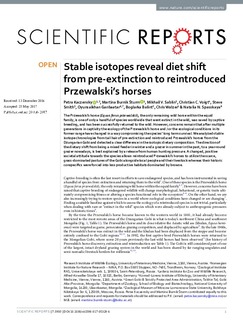| dc.contributor.author | Kaczensky, Petra | |
| dc.contributor.author | Šturm, Martina Burnik | |
| dc.contributor.author | Sablin, Mikhail V. | |
| dc.contributor.author | Voigt, Christian C. | |
| dc.contributor.author | Smith, Steve | |
| dc.contributor.author | Ganbaatar, Oyunsaikhan | |
| dc.contributor.author | Balint, Boglarka | |
| dc.contributor.author | Walzer, Chris | |
| dc.contributor.author | Spasskaya, Natalia N. | |
| dc.date.accessioned | 2018-11-14T14:23:17Z | |
| dc.date.available | 2018-11-14T14:23:17Z | |
| dc.date.created | 2018-01-31T12:41:03Z | |
| dc.date.issued | 2017 | |
| dc.identifier.citation | Scientific Reports. 2017, 7 (5950), 1-9. | nb_NO |
| dc.identifier.issn | 2045-2322 | |
| dc.identifier.uri | http://hdl.handle.net/11250/2572893 | |
| dc.description.abstract | The Przewalski’s horse (Equus ferus przewalskii), the only remaining wild horse within the equid family, is one of only a handful of species worldwide that went extinct in the wild, was saved by captive breeding, and has been successfully returned to the wild. However, concerns remain that after multiple generations in captivity the ecology of the Przewalski’s horse and / or the ecological conditions in its former range have changed in a way compromising the species’ long term survival. We analyzed stable isotope chronologies from tail hair of pre-extinction and reintroduced Przewalski’s horses from the Dzungarian Gobi and detected a clear difference in the isotopic dietary composition. The direction of the dietary shift from being a mixed feeder in winter and a grazer in summer in the past, to a year-round grazer nowadays, is best explained by a release from human hunting pressure. A changed, positive societal attitude towards the species allows reintroduced Przewalski’s horses to utilize the scarce, grass-dominated pastures of the Gobi alongside local people and their livestock whereas their historic conspecifics were forced into less productive habitats dominated by browse. | nb_NO |
| dc.language.iso | eng | nb_NO |
| dc.rights | Attribution-NonCommercial-NoDerivatives 4.0 Internasjonal | * |
| dc.rights.uri | http://creativecommons.org/licenses/by-nc-nd/4.0/deed.no | * |
| dc.title | Stable isotopes reveal diet shift from pre-extinction to reintroduced Przewalski's horses | nb_NO |
| dc.type | Journal article | nb_NO |
| dc.type | Peer reviewed | nb_NO |
| dc.description.version | publishedVersion | nb_NO |
| dc.subject.nsi | VDP::Zoologiske og botaniske fag: 480 | nb_NO |
| dc.subject.nsi | VDP::Zoology and botany: 480 | nb_NO |
| dc.source.pagenumber | 1-9 | nb_NO |
| dc.source.volume | 7 | nb_NO |
| dc.source.journal | Scientific Reports | nb_NO |
| dc.source.issue | 5950 | nb_NO |
| dc.identifier.doi | 10.1038/s41598-017-05329-6 | |
| dc.identifier.cristin | 1558379 | |
| dc.relation.project | Andre: Austrian Science Fund | nb_NO |
| cristin.unitcode | 7511,2,0,0 | |
| cristin.unitname | Avdeling for terrestrisk økologi | |
| cristin.ispublished | true | |
| cristin.fulltext | original | |
| cristin.qualitycode | 1 | |

